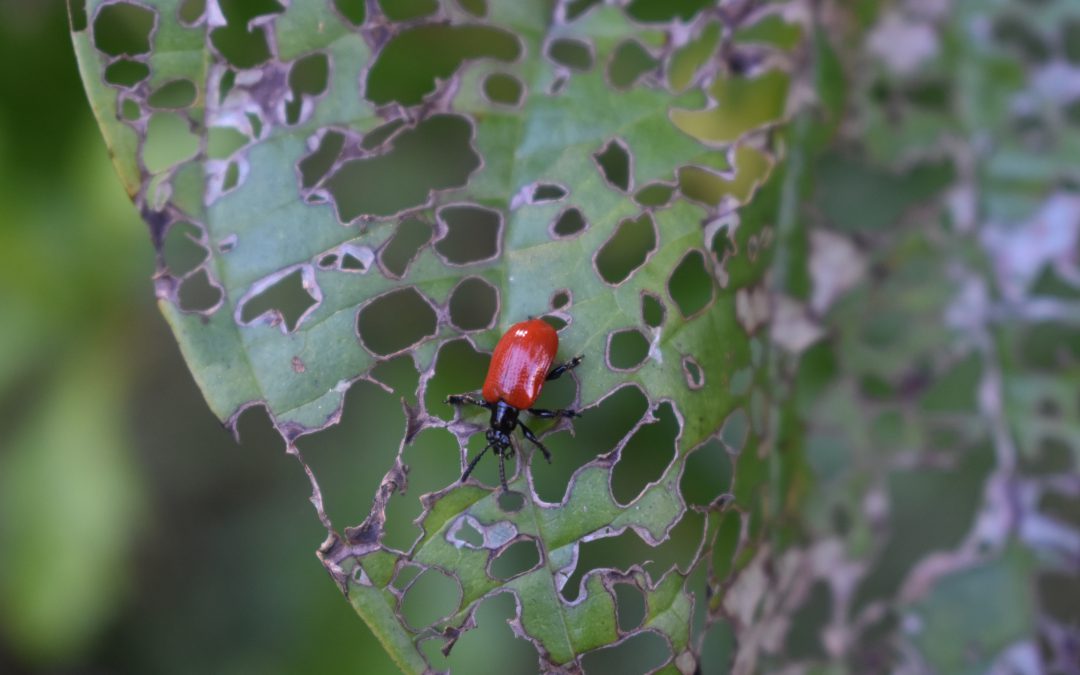
by Danielle S. Williams | Feb 3, 2022
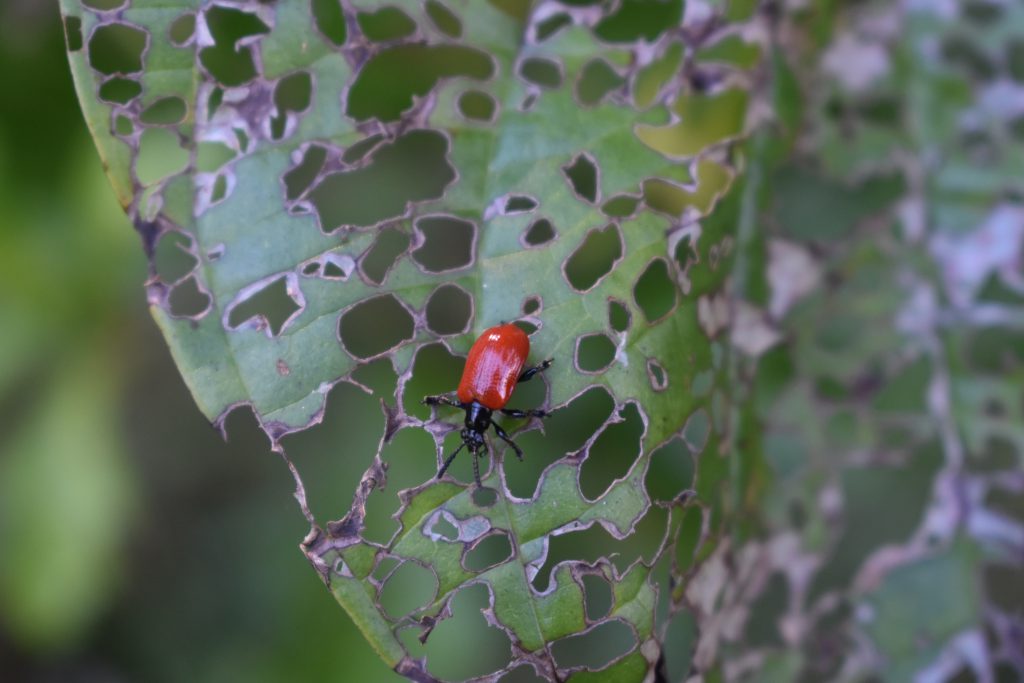
Air Potato Leaf Beetle
I’m sure many of you could easily recognize air potato with its winding vines and heart-shaped leaves climbing high along roadsides, fencerows and natural vegetation, but could you recognize its key predator, the air potato leaf beetle? Believe it or not, a small, red leaf-feeding beetle was introduced and is here to help control the invasive air potato vine!
The Issue with Air Potato Vine
Air potato (Dioscorea bulbifera) is a plant species that is native to Asia and was first introduced to the United States as a landscape plant but has now become one of Florida’s most problematic invasive plants. Air potato has spread to 60 of the 67 counties in Florida, including many in the Panhandle. Air potato vines can grow up to 8 inches per day! The dense vines smother vegetation and displace native plants, trees and animals. The air potato vine is on the Florida Noxious Weed List. This means that is illegal to plant, propagate or move the air potato unless you have a permit.
The air potato vine spreads by vegetative reproduction. This is through the formation of aerial tubers, or bulbils that are formed in the leaf axils. The aerial tubers are roundish and vary in size. In addition to aerial tubers, air potato also produces underground tubers, making control that much more difficult. During the winter, the aerial tubers will drop to the ground and give rise to new vines in the spring.
Park managers and homeowners throughout Florida have battled with the air potato as its covered our landscape. For years, the primary means of control were by manually pulling, digging and destroying the tubers or by herbicide applications, until recently.
Classical Biological Control of the Air Potato Vine
Another method for controlling invasive plants is with classical biological control. This method involves searching for insects that feed exclusively on a plant in its native range and releasing them in an area that has been invaded by the plant. Scientists with the United States Department of Agriculture discovered the air potato leaf beetle (Lilioceris cheni) that feeds on air potato in its native range of Asia. After extensive testing, scientist found that the beetle is species-specific and poses no risk to other plant species.
In 2012, air potato leaf beetles were first released in Florida to help battle the air potato. Now, according to the Florida Department of Agriculture and Consumer Services (FDACS), they are officially established in the state! This means, they are here to stay and research has shown they are helping!
While you likely won’t see the beetles now, because they are overwintering (a period of suspended development), look for them in the spring! Adults are bright red with a black head and legs and about the size of your pinky fingernail. The females lay white, pale eggs on the underside of leaves. The egg-laying process causes the leaves to curl and cup. In addition to that, larvae feed on the leaves skeletonizing them. This feeding by the beetle negatively affects the growth and reproduction of the plant.
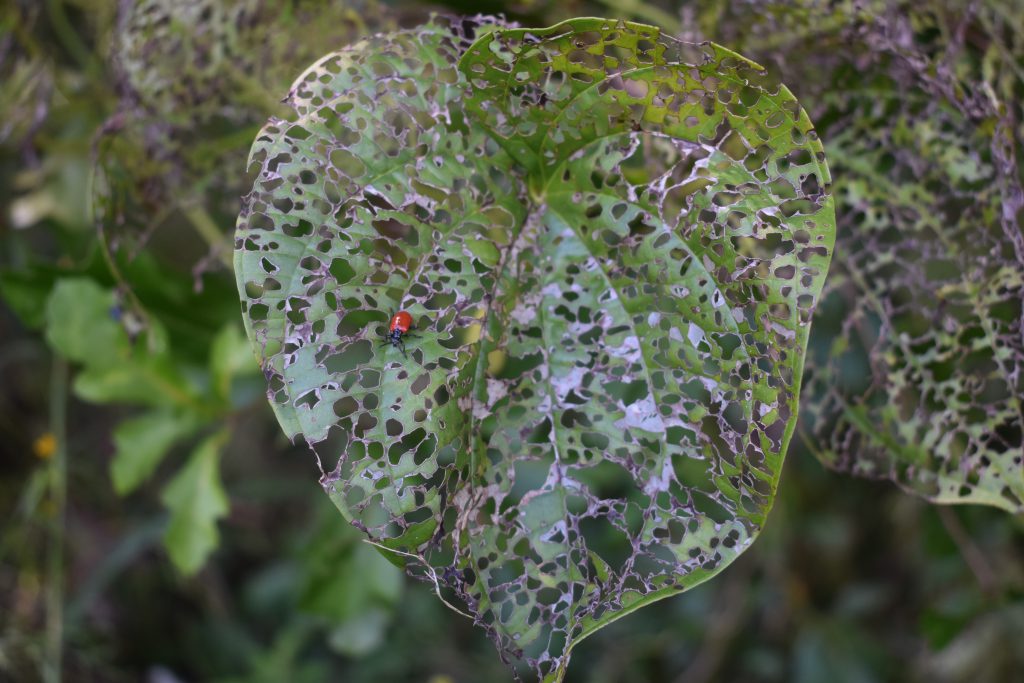
Skeletonized leaf damage to Air Potato from the Air Potato Leaf Beetle. Photo: Danielle Sprague
For more information on air potato leaf beetles, please visit:
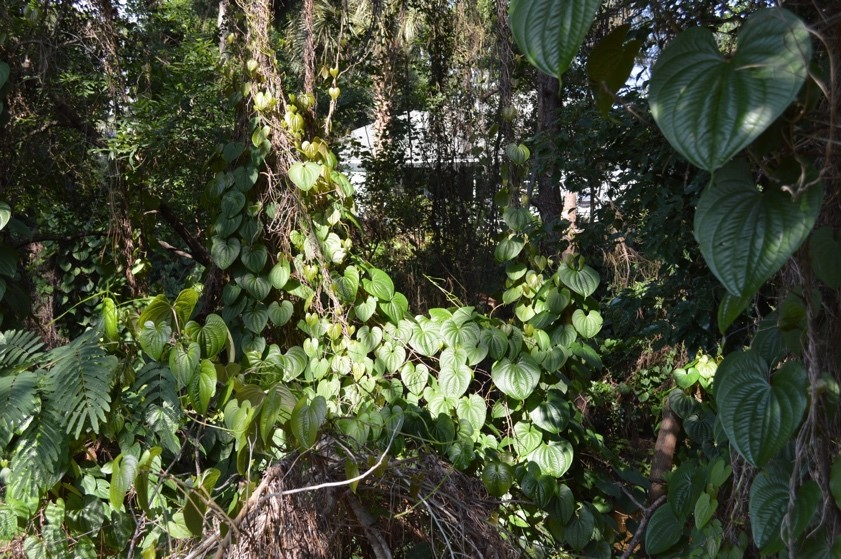
by Scott Jackson | Feb 14, 2020
February is a month filled with special celebrations and events like Valentine’s Day, President’s Day, Groundhog Day, and of course NISAW!
NISAW or National Invasive Species Awareness Week isn’t as famous or beloved as the other February dates. You likely won’t get a day off, have a special date or receive a present from your loved ones. However, NISAW is an important time to remember and learn about invasive species that impact our beloved natural areas.
Invasive species originate from other continents and have adverse impacts on our native habitats and species. Many of these problem non-natives have nothing to keep them in check since there’s nothing that eats or preys on them in their “new world”.
This year NISAW is being celebrated February 24 – 28. It is the largest invasive species awareness effort in the U.S. You can learn more at https://www.nisaw.org/nisaw-2020/
or on Facebook at @invasivespeciesweek. Search other social media outlets using #NISAW or #invasivespecies.
We would like you to help celebrate NISAW in a more meaningful way, beyond awareness and clicking a few links or sharing social media posts with your friends. Bay County and Northwest Florida need your help in fighting invasive species this year, especially the air potato vine.
Air potato vine originated in Asia and Africa. It was brought to Florida in the early 1900s. People moved this plant with them, having used it in the past for food and medicine. Today, we know raw forms of air potato are toxic and consumption is not recommended. This quick growing vine reproduces from tubers or “potatoes”. The potato drops from the vine and grows into the soil to start new vines. Air potato is especially a problem in disturbed areas like utility easements, which can provide easy entry into forests. Significant damage can occur in areas with heavy air potato infestation because vines can entirely cover large trees. Some sources report vine growth rates up to eight inches per day!
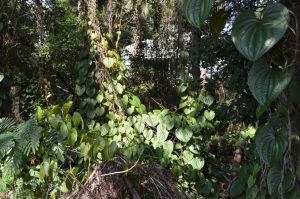
Air potato vines covering shrubs and trees in Bay County Florida.
Photo: Scott Jackson
We plan to start local NISAW activities a few days early on February 22nd, with the collection of air potato vine tubers or potatoes also known as bulbils of this species. Bay County Conservancy will host an “Air Potato Round-Up” behind Panama City Orthopedics in the Audubon Nature Preserve which is located at State Ave and 19th Street. The collection and workday is scheduled from 9am until Noon. Volunteers are encouraged to wear long pants, gloves, comfortable shoes or waterproof boots. Expect a rewarding but dirty job! For details and specific information please contact Teresa Nooney at 850-814-4755.
Other communities are promoting other NISAW workdays and events known collectively as “Weed Wrangle”. UF/IFAS Extension Bay County and Escambia County will serve as collection sites for Air Potato vine bulbils through the last week of February as permitted and designated by the Florida Department of Agriculture and Consumer Services (FDACS). For additional details contact and coordinate delivery with your county UF/IFAS Extension Office.
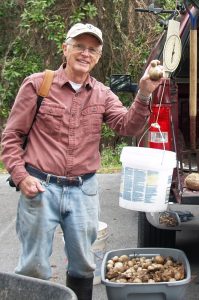
Ron Houser weighs collected air potato bulbils.
Photo: Teresa Nooney
Because air potato vine is a regulated invasive species, only UF/IFAS Extension offices working directly with FDACS under their permit will be able to accept air potatoes. Air potatoes must be delivered in person, you cannot mail or ship them. Participating offices are:
UF/IFAS Extension Bay County, https://sfyl.ifas.ufl.edu/bay , 850-248-8091.
UF/IFAS Extension Escambia County, http://sfyl.ifas.ufl.edu/escambia , 850-475-5230.
Unfortunately, mechanical removal of vines and herbicide applications is difficult and may cause harm to desirable plants making it very difficult to manage. Removing and collecting air potato vine tubers helps in the control of this plant. When the potatoes are left in place, they will produce new vines the following spring.
The bubils that are collected by local UF/IFAS Extension offices will be given to Florida Department of Consumer Services (FDACS) air potato beetle rearing labs. This will help them raise more beetles that can be distributed throughout the state for establishment and vine control.

Air potato beetle crawling on a leaf stem.
Photo: Julie McConnell
The air potato leaf beetle was released in Florida in 2011. This beetle was originally identified as a natural predator of air potato vine within its native range and was found to be effective in keeping growth in check as well as being safe to other plants because it has such a specific dietary source. Air potato leaf beetles eat only air potato vines! Only after years of extensive research to ensure the safety of Florida ecosystems, was the air potato leaf beetle cleared as for use as a biological control insect to aid in the control of air potato vine. Air potato beetle releases are monitored and evaluated by United States Department of Agriculture (USDA) researchers and scientists as they continue to establish populations and monitor the work of air potato vine leaf beetles throughout the state.
An Equal Opportunity Institution. UF/IFAS Extension, University of Florida, Institute of Food and Agricultural Sciences, Nick T. Place, Dean for UF/IFAS Extension. Single copies of UF/IFAS Extension publications (excluding 4-H and youth publications) are available free to Florida residents from county UF/IFAS Extension offices.
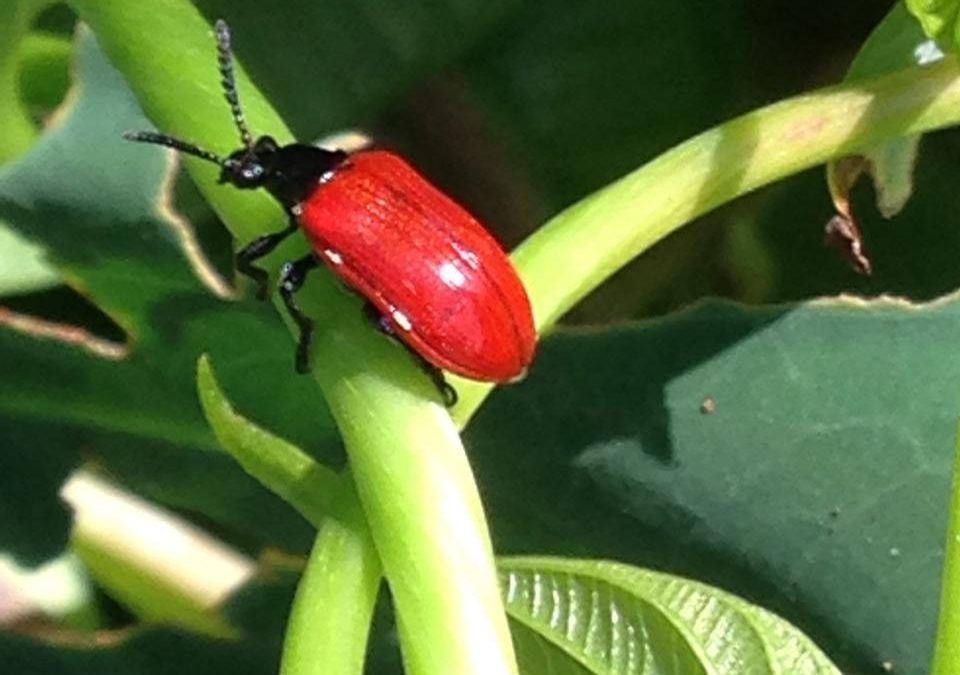
by Sheila Dunning | Feb 26, 2016
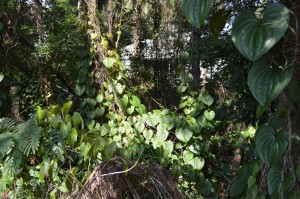
Air potato vine. Photo by Scott Jackson
Air potato (Dioscores bulbifera) is a perennial, herbaceous self-twining vine that can grow over 60 feet in length, enabling it to climb over and smother many native plants. The Florida Exotic Plant Pest Council (FLEPPC) lists air potato as a Category 1 invasive plant, which means that it has disrupted natural communities and ecological functions by displacing native plant species.
In 2012, a leaf feeding beetle (Lilioceris cheni) was introduced into South Florida from China for biological control of air potato. Although it is too early to determine any potential long-term impacts, the initial results have been promising. The larvae and adults of the air potato leaf beetle feed on the leaf tissue and occasionally the bulbils. The damage to the growing tips of the plant have dramatically reduced its ability to cover native vegetation. Extensive damage to air potato was evident within three months after the first release. Additionally, testing by scientists at the USDA/ARS Invasive Plant Research Laboratory in Fort Lauderdale concluded that the beetle will not complete development on any other plant found in Florida.
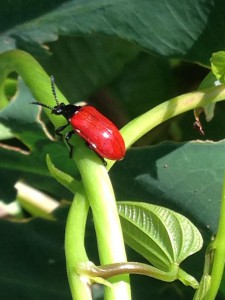
Air potato beetle up close. Photo by Julie McConnell
The female air potato leaf beetle lays an average of 1,200 eggs, which develop into larvae in about four days. The young beetles skeletonize the air potato leaves for the next eight days and then pupate into foam-like cocoons. Clumps of cocoons fall to the ground and the adult beetles emerge 13 to 16 days later. There can be a new generation of air potato leaf beetle every month while the weather is warm. For the winter, the adults hide in leaf litter and wait for spring.
The question now is: “How well will they survive through a longer, colder Northwest Florida winter?”. USDA scientists, UF Extension agents and citizen scientists in Bay and Okaloosa County hope to find out. Earlier this month, June 2015, air potato leaf beetles from the Hayslip Biological Control and Research and Containment Laboratory in Ft. Pierce were released into areas containing air potato. They will be monitored over the next year. Look for an update this coming summer.










